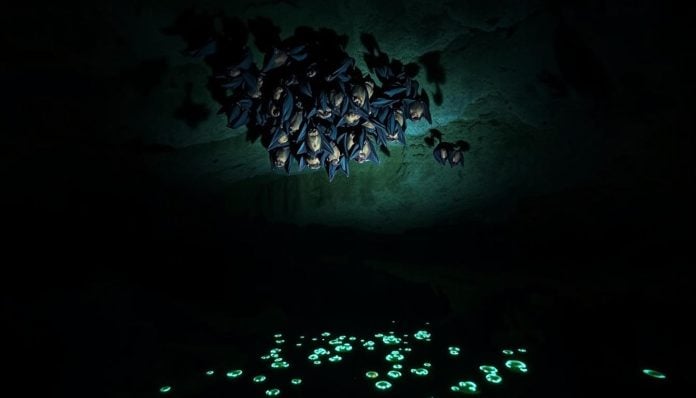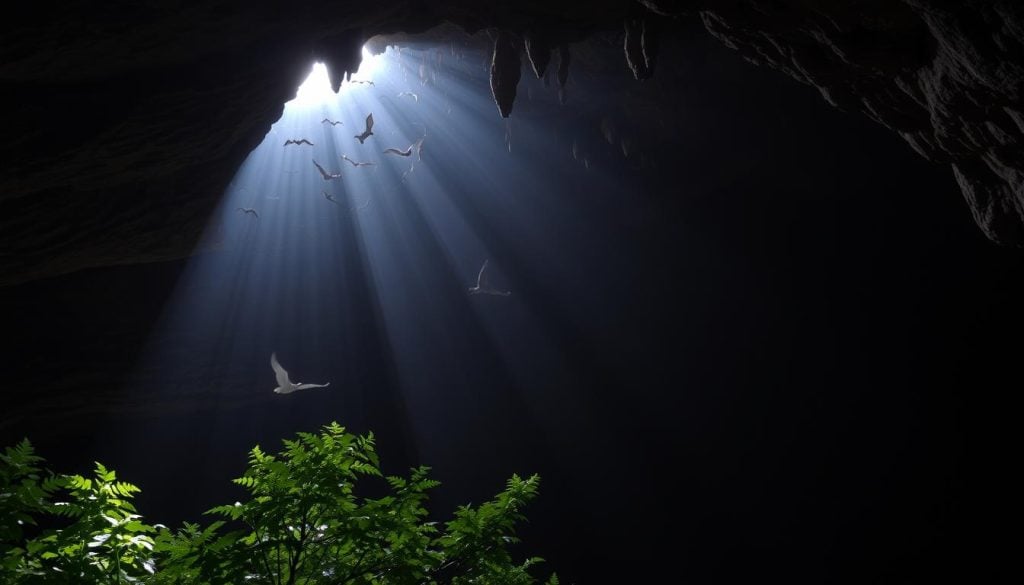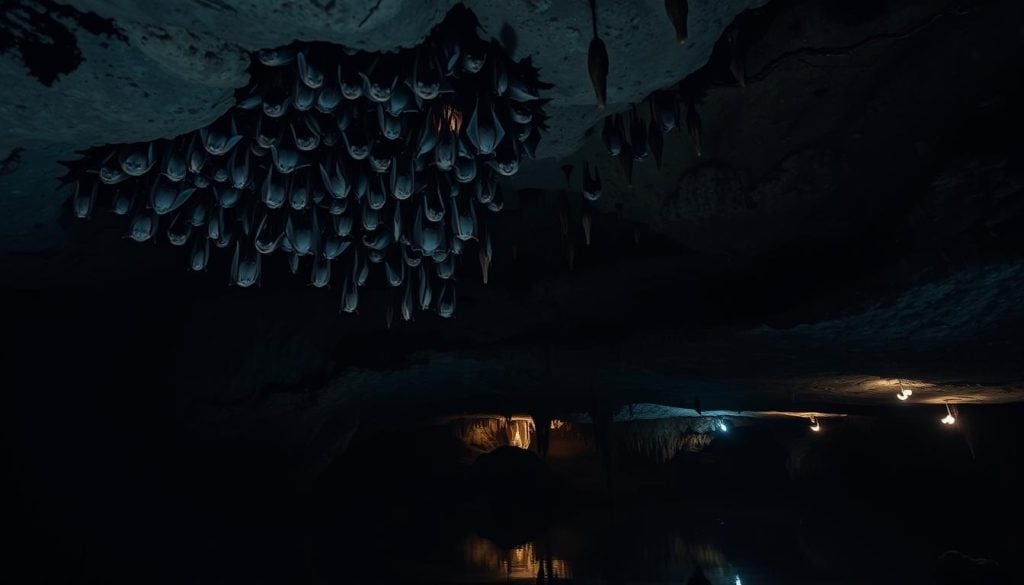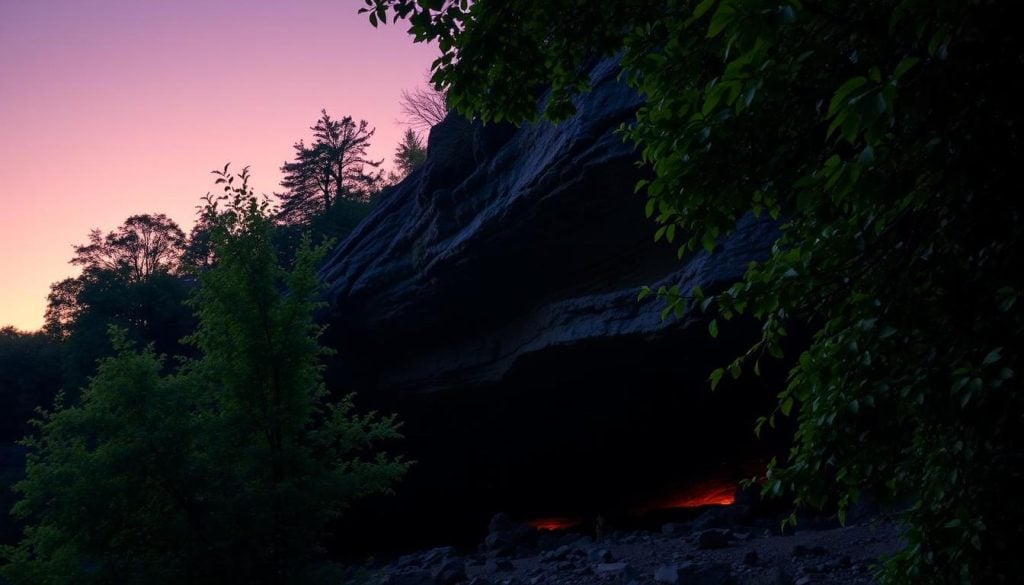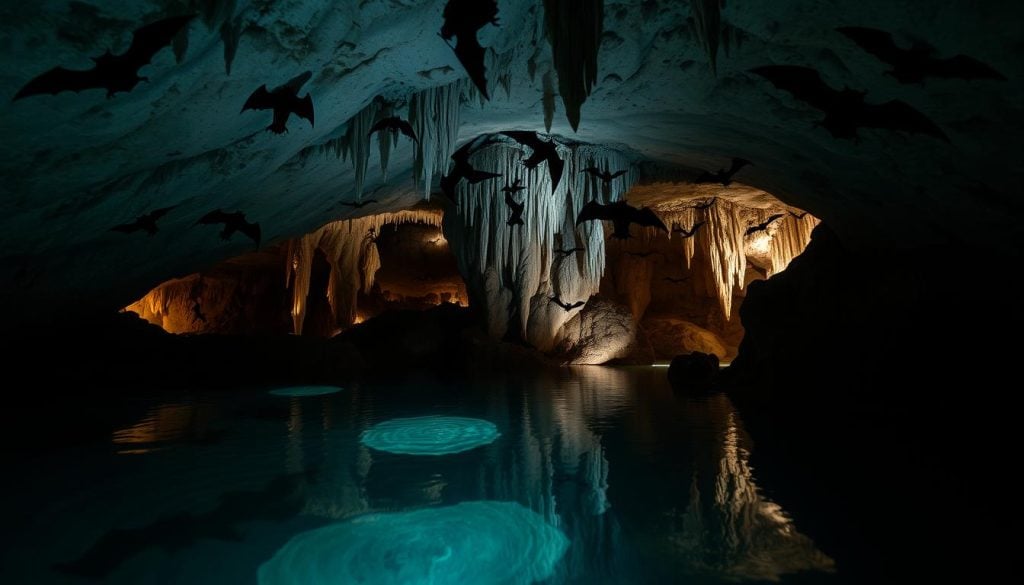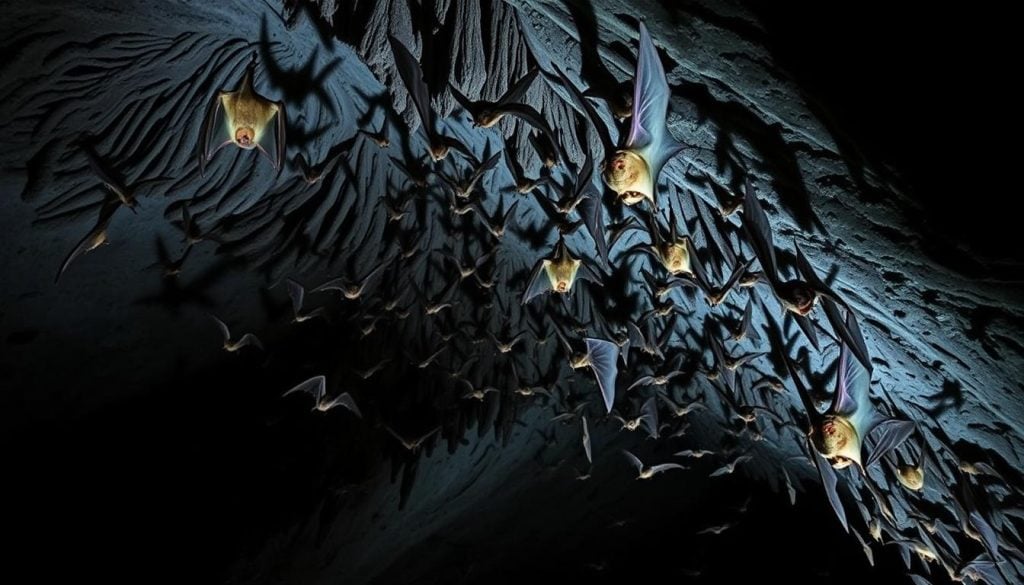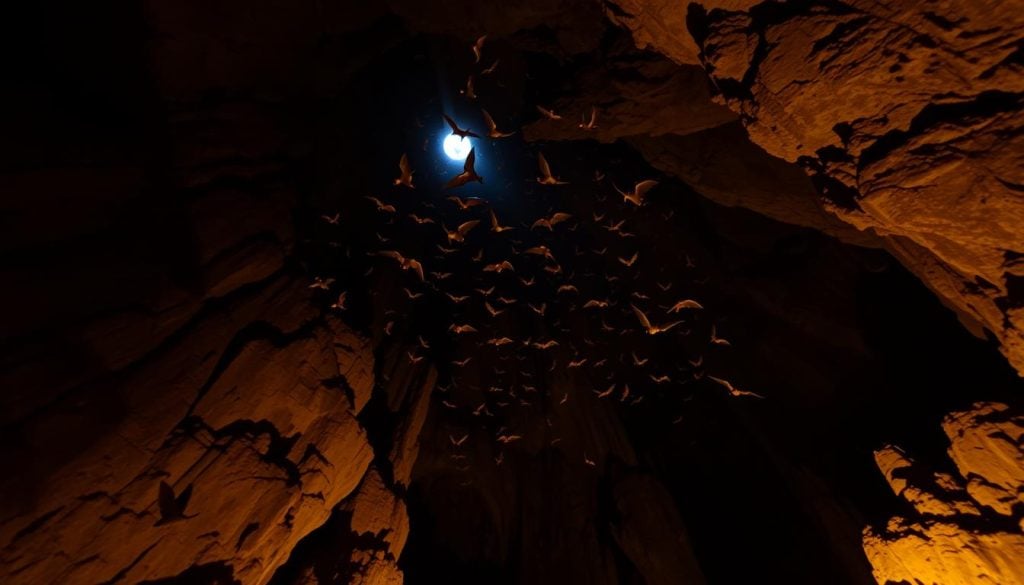Ever thought, can you see bats in Mammoth Cave National Park? This park is a hotspot for 13 bat species, making it a top spot for watching bats in the U.S. As you explore, you’ll see the cave’s beauty and learn how bats help our planet. Let’s dive into Mammoth Cave bat tours to find the best times and places to see these amazing creatures.
Introduction to Mammoth Cave National Park
Mammoth Cave National Park is in central Kentucky and is the longest cave system in the world, over 400 miles long. It’s not just a maze of tunnels but a home for a wide variety of wildlife.
The park’s caves and underground rivers support a rich ecosystem. You’ll find many plant and animal species living here. It’s also a key place for bats, which are important for the environment.
Learning about Mammoth Cave National Park shows us how important it is for nature. It highlights the role of bats in keeping the ecosystem healthy and diverse.
| Feature | Description |
|---|---|
| Length of Cave System | Over 400 miles |
| Location | Central Kentucky |
| Diverse Wildlife | Includes various bat species, plants, and animals |
| Environmental Significance | Supports ecosystem balance and biodiversity |
Can you see bats in Mammoth Cave National Park?
Many visitors ask, can you see bats in Mammoth Cave National Park? To spot these creatures, knowing where they live and act is key. Bats live in dark spots like cave entrances and small spaces. These places keep them safe from predators.
The bats in Mammoth Cave don’t leave the caves together like some do. They go out one by one. This makes it harder to see them.
Understanding Bat Habitats and Behavior
Watching bats is best at dusk when they go out to hunt. Look for them near lights, like in parking lots where bugs gather. Learning about their habits helps you see them better. Knowing when and where they are active makes your visit more interesting.
| Aspect | Details |
|---|---|
| Roosting Locations | Dark, secluded spaces such as cave entrances and crevices |
| Emergence Behavior | Individual rather than mass exit from caves |
| Active Hours | Dusk is the prime time for observation |
| Feeding Behavior | Hunt flying insects, often near light sources |
Mammoth Cave Bat Species
Mammoth Cave National Park is a key place for many bat species. It shows a wide variety of life. With 13 different bat types, the park helps keep the environment balanced and protects unique wildlife. Seeing these bats can make your visit more interesting, showing how they live underground.
Diverse Species in the Park
The park is home to bats like the Rafinesque’s big-eared bat, little brown bat, and northern long-eared bat. These bats help the ecosystem by controlling pests and pollinating plants. Learning about their lives and homes helps us value their roles in nature. Some of the different bats you can find here are:
- Rafinesque’s Big-Eared Bat
- Little Brown Bat
- Northern Long-Eared Bat
- Eastern Red Bat
- Indiana Bat
Endangered Species and Conservation Efforts
Many bat species in the park face big threats like climate change, losing their homes, and a deadly disease called White-nose Syndrome. These threats are very serious and need action. Conservation efforts are happening to protect these important bats and their homes.
Groups are working together to watch the bat populations, fix their homes, and teach visitors about these issues. These efforts are helping to save the affected species. Learning about these projects shows why it’s crucial to protect the park’s nature.
Mammoth Cave Bat Tours
Mammoth Cave National Park offers a great chance for wildlife lovers with its Mammoth Cave bat tours. These tours show off the cave’s beauty and focus on the amazing bats that live there. Knowing what to expect makes your visit unforgettable and fun.
Overview of Available Tours
There are many Mammoth Cave tours for different interests. Some focus on the cave’s stunning rocks, while others dive deep into bat life. These tours are usually in the warmer months. They highlight how bats help the ecosystem and the work to protect them.
What to Expect During a Tour
On a Mammoth Cave bat tour, a knowledgeable guide will take you on an exciting journey. You’ll learn about the cave’s rocks, climate, and wildlife, especially the bats. Topics covered include:
- The historical significance and formation of Mammoth Cave
- Conservation efforts for bats
- How bats live in the ecosystem
- How to watch bats without bothering them
With the right prep and knowledge, your trip to Mammoth Cave will be both fun and enlightening.
| Tour Type | Duration | Focus Area | Best Season |
|---|---|---|---|
| Mammoth Cave Bat Tour | 2 hours | Bat viewing and ecology | Spring and Summer |
| Traditional Cave Tour | 1.5 hours | Geological formations | Year-round |
| Wildlife Exploration Tour | 3 hours | Bats and other wildlife | Spring and Fall |
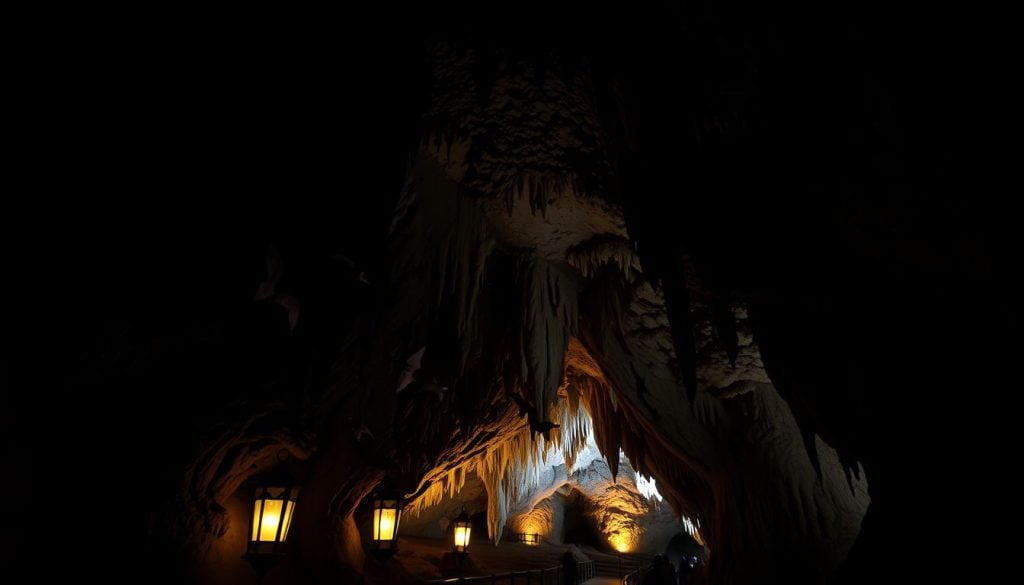
Best Time to See Bats at Mammoth Cave
To see bats at Mammoth Cave National Park, knowing when they are most active is key. They are usually out more in the warmer months, from late spring to early fall. This is when they mate and forage, making it a great time for visitors to watch them.
Seasonal Patterns and Bat Activity
The best time to see bats at Mammoth Cave is when they are most active. This happens at dusk during their peak season. Knowing when they come out can make your visit better. Different bats have different habits, so learning about them helps plan your trip.
Timing Your Visit for Optimal Sightings
For a good chance of seeing bats, visit in the evening. Get to the park before sunset to find a good spot. Here are some practical tips for a successful bat sighting:
- Look for popular spots like cave entrances or areas with lights that attract insects.
- Be patient and ready to wait for the bats to show up.
- Bring binoculars for a closer look at the bats flying around.
Visiting during the best time for bat activity increases your chances of a great experience at Mammoth Cave National Park.
Where to Spot Bats in Mammoth Cave
Starting a bat watching adventure in Mammoth Cave National Park can be thrilling. Knowing where to find bats can make your experience even better. The park has special spots that are great for seeing bats. Here are some top places and tips for spotting them.
Popular Locations for Bat Watching
There are several spots in Mammoth Cave that are perfect for seeing bats. Here are some of the best places:
- Visitor Center Parking Lot: This spot is full of insects at dusk, making it great for watching bats.
- Historic Entrance: Near the cave’s main entrance, you can see bats as they go out to feed at night.
- Frozen Niagara: Here, you can see amazing cave formations and watch bats in their natural setting.
Tips for a Successful Bat Sighting
Here are some tips to help you see bats:
- Be quiet when you approach viewing areas to not scare the bats.
- Use binoculars to see the bats up close without bothering them.
- Wear warm clothes for the cool evening and bring snacks and water to stay energized.
- Always keep a safe distance from the bats and respect their space.
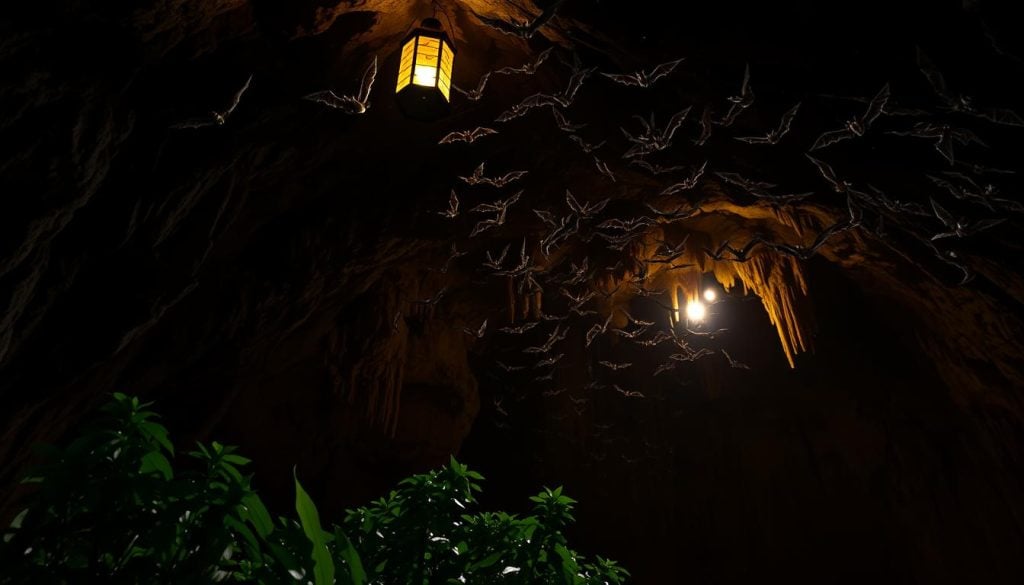
By picking the right spots and following these tips, you can see the amazing behavior of bats at Mammoth Cave National Park.
Experience Bat Watching in Mammoth Cave
To truly enjoy your time, plan your visit with care. Learn about the different aspects of bat watching to make your adventure better. Knowing the best times and places to see bats will lead to great experiences.
Planning Your Bat Watching Experience
Getting ready for bat watching in Mammoth Cave is crucial. Learn about the species and their behaviors. Look into seasonal patterns; some months are better for sightings. Guided tours can give you more insights and take you to the best spots.
What to Bring for an Enjoyable Visit
Knowing what to bring makes your bat watching trip fun and comfy. You’ll need:
- Flashlight – Useful for exploring dark areas.
- Binoculars – For a closer look at bats in flight.
- Comfortable clothing – Dress in layers to adjust to changing temperatures.
- Insect repellent – Keeps pesky bugs at bay, especially in warmer months.
- Camera – Capture memories of your encounters.
- Notebook – Document your observations and experiences.
With these essentials, you’re all set for a memorable bat watching experience.
Mammoth Cave Bat Population
The Mammoth Cave bat population is key to the park’s ecosystem health. Knowing how many bats there are helps us understand their well-being and the problems they face.
Current Status of Bat Population
Recent checks show the Mammoth Cave bat population is down. White-nose Syndrome, a fungal disease, is the main reason. It has hit the little brown bat and northern long-eared bat hard. Conservation efforts are working to keep track of these bats and help them.
Impact of Environmental Changes on Bats
Environmental changes affect bats a lot, making their situation worse in Mammoth Cave. Loss of habitat, climate change, and pollution harm their homes and food. These changes make it hard for bats to survive and reproduce. We need to tackle these issues to help bats and keep the ecosystem healthy.
| Bats Affected | Population Decline (%) | Main Threats |
|---|---|---|
| Little Brown Bat | 90% | White-nose Syndrome |
| Northern Long-Eared Bat | 80% | White-nose Syndrome |
| Gray Bat | 50% | Habitat Loss |
By studying the Mammoth Cave bat population, we can find ways to fight environmental changes. This will help protect these important species.
Witnessing Bats in Mammoth Cave
For those eager to see bats in Mammoth Cave, there are special events and tours. These happen during peak months, offering insights from experts. They help you appreciate these creatures and their role in nature.
Special Events or Tours for Bat Lovers
Special bat events and tours are available throughout the year. You can watch bats up close and learn about their conservation. Guides talk about how bats help control pests and pollinate plants.
- Scheduled evening bat watches during peak activity times.
- Informative talks from wildlife experts about bat conservation efforts.
- Hands-on activities aimed at enriching the learning experience.
Personal Accounts of Bat Sightings
Visitors share stories of their bat sightings in Mammoth Cave. These stories make future visits more exciting. They tell of the thrill of seeing bats leave the cave at dusk, against the twilight sky.
“Watching bats emerge from the cave was truly magical. It’s an experience that remains etched in my memory.” – A satisfied visitor.
Expert-led events and personal stories make Mammoth Cave a great place for nature lovers. Learning about bat behavior and hearing stories makes your visit more meaningful. Dive into the world of bats in this magical place.
Conclusion
Visiting Mammoth Cave National Park to watch bats is a unique chance to connect with nature. You’ll see how these amazing creatures play a key role in the ecosystem. They help control pests, pollinate plants, and spread seeds, showing why we need to protect them.
Learning about the different bat species at Mammoth Cave deepens your love for nature. This experience makes your visit more meaningful and teaches you to care for these misunderstood animals. It’s important to know how to help protect them.
With the tips from this article, you’re ready for an amazing bat watching trip. The right timing and preparation lead to unforgettable moments with these fascinating creatures. Take this chance to enjoy nature and discover the beauty of Mammoth Cave National Park.

































